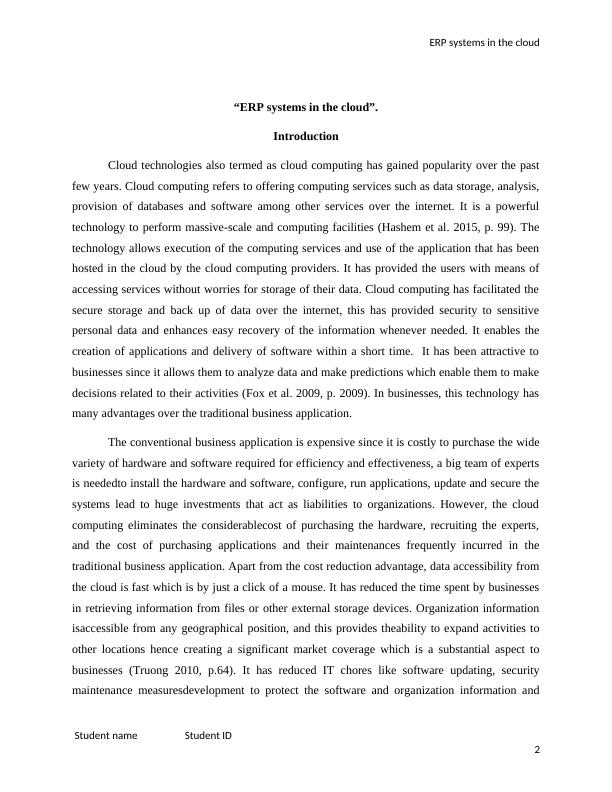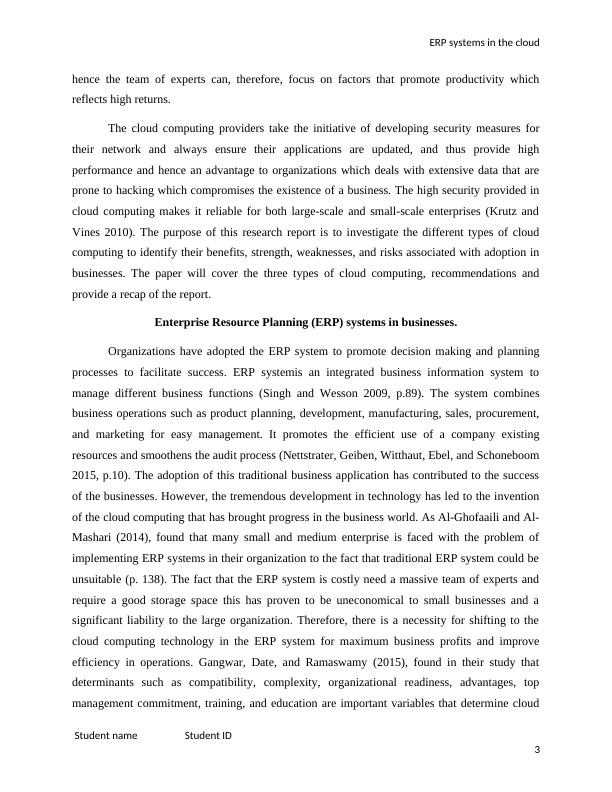ERP Systems in the Cloud: Types, Benefits, and Risks
Added on 2023-06-07
9 Pages3049 Words94 Views
ERP systems in the cloud
“ERP SYSTEM IN THE CLOUD”
Name
Course
Professor’s name
Institution
Location of the institution
Date
Student name Student ID
1
“ERP SYSTEM IN THE CLOUD”
Name
Course
Professor’s name
Institution
Location of the institution
Date
Student name Student ID
1

ERP systems in the cloud
“ERP systems in the cloud”.
Introduction
Cloud technologies also termed as cloud computing has gained popularity over the past
few years. Cloud computing refers to offering computing services such as data storage, analysis,
provision of databases and software among other services over the internet. It is a powerful
technology to perform massive-scale and computing facilities (Hashem et al. 2015, p. 99). The
technology allows execution of the computing services and use of the application that has been
hosted in the cloud by the cloud computing providers. It has provided the users with means of
accessing services without worries for storage of their data. Cloud computing has facilitated the
secure storage and back up of data over the internet, this has provided security to sensitive
personal data and enhances easy recovery of the information whenever needed. It enables the
creation of applications and delivery of software within a short time. It has been attractive to
businesses since it allows them to analyze data and make predictions which enable them to make
decisions related to their activities (Fox et al. 2009, p. 2009). In businesses, this technology has
many advantages over the traditional business application.
The conventional business application is expensive since it is costly to purchase the wide
variety of hardware and software required for efficiency and effectiveness, a big team of experts
is neededto install the hardware and software, configure, run applications, update and secure the
systems lead to huge investments that act as liabilities to organizations. However, the cloud
computing eliminates the considerablecost of purchasing the hardware, recruiting the experts,
and the cost of purchasing applications and their maintenances frequently incurred in the
traditional business application. Apart from the cost reduction advantage, data accessibility from
the cloud is fast which is by just a click of a mouse. It has reduced the time spent by businesses
in retrieving information from files or other external storage devices. Organization information
isaccessible from any geographical position, and this provides theability to expand activities to
other locations hence creating a significant market coverage which is a substantial aspect to
businesses (Truong 2010, p.64). It has reduced IT chores like software updating, security
maintenance measuresdevelopment to protect the software and organization information and
Student name Student ID
2
“ERP systems in the cloud”.
Introduction
Cloud technologies also termed as cloud computing has gained popularity over the past
few years. Cloud computing refers to offering computing services such as data storage, analysis,
provision of databases and software among other services over the internet. It is a powerful
technology to perform massive-scale and computing facilities (Hashem et al. 2015, p. 99). The
technology allows execution of the computing services and use of the application that has been
hosted in the cloud by the cloud computing providers. It has provided the users with means of
accessing services without worries for storage of their data. Cloud computing has facilitated the
secure storage and back up of data over the internet, this has provided security to sensitive
personal data and enhances easy recovery of the information whenever needed. It enables the
creation of applications and delivery of software within a short time. It has been attractive to
businesses since it allows them to analyze data and make predictions which enable them to make
decisions related to their activities (Fox et al. 2009, p. 2009). In businesses, this technology has
many advantages over the traditional business application.
The conventional business application is expensive since it is costly to purchase the wide
variety of hardware and software required for efficiency and effectiveness, a big team of experts
is neededto install the hardware and software, configure, run applications, update and secure the
systems lead to huge investments that act as liabilities to organizations. However, the cloud
computing eliminates the considerablecost of purchasing the hardware, recruiting the experts,
and the cost of purchasing applications and their maintenances frequently incurred in the
traditional business application. Apart from the cost reduction advantage, data accessibility from
the cloud is fast which is by just a click of a mouse. It has reduced the time spent by businesses
in retrieving information from files or other external storage devices. Organization information
isaccessible from any geographical position, and this provides theability to expand activities to
other locations hence creating a significant market coverage which is a substantial aspect to
businesses (Truong 2010, p.64). It has reduced IT chores like software updating, security
maintenance measuresdevelopment to protect the software and organization information and
Student name Student ID
2

ERP systems in the cloud
hence the team of experts can, therefore, focus on factors that promote productivity which
reflects high returns.
The cloud computing providers take the initiative of developing security measures for
their network and always ensure their applications are updated, and thus provide high
performance and hence an advantage to organizations which deals with extensive data that are
prone to hacking which compromises the existence of a business. The high security provided in
cloud computing makes it reliable for both large-scale and small-scale enterprises (Krutz and
Vines 2010). The purpose of this research report is to investigate the different types of cloud
computing to identify their benefits, strength, weaknesses, and risks associated with adoption in
businesses. The paper will cover the three types of cloud computing, recommendations and
provide a recap of the report.
Enterprise Resource Planning (ERP) systems in businesses.
Organizations have adopted the ERP system to promote decision making and planning
processes to facilitate success. ERP systemis an integrated business information system to
manage different business functions (Singh and Wesson 2009, p.89). The system combines
business operations such as product planning, development, manufacturing, sales, procurement,
and marketing for easy management. It promotes the efficient use of a company existing
resources and smoothens the audit process (Nettstrater, Geiben, Witthaut, Ebel, and Schoneboom
2015, p.10). The adoption of this traditional business application has contributed to the success
of the businesses. However, the tremendous development in technology has led to the invention
of the cloud computing that has brought progress in the business world. As Al-Ghofaaili and Al-
Mashari (2014), found that many small and medium enterprise is faced with the problem of
implementing ERP systems in their organization to the fact that traditional ERP system could be
unsuitable (p. 138). The fact that the ERP system is costly need a massive team of experts and
require a good storage space this has proven to be uneconomical to small businesses and a
significant liability to the large organization. Therefore, there is a necessity for shifting to the
cloud computing technology in the ERP system for maximum business profits and improve
efficiency in operations. Gangwar, Date, and Ramaswamy (2015), found in their study that
determinants such as compatibility, complexity, organizational readiness, advantages, top
management commitment, training, and education are important variables that determine cloud
Student name Student ID
3
hence the team of experts can, therefore, focus on factors that promote productivity which
reflects high returns.
The cloud computing providers take the initiative of developing security measures for
their network and always ensure their applications are updated, and thus provide high
performance and hence an advantage to organizations which deals with extensive data that are
prone to hacking which compromises the existence of a business. The high security provided in
cloud computing makes it reliable for both large-scale and small-scale enterprises (Krutz and
Vines 2010). The purpose of this research report is to investigate the different types of cloud
computing to identify their benefits, strength, weaknesses, and risks associated with adoption in
businesses. The paper will cover the three types of cloud computing, recommendations and
provide a recap of the report.
Enterprise Resource Planning (ERP) systems in businesses.
Organizations have adopted the ERP system to promote decision making and planning
processes to facilitate success. ERP systemis an integrated business information system to
manage different business functions (Singh and Wesson 2009, p.89). The system combines
business operations such as product planning, development, manufacturing, sales, procurement,
and marketing for easy management. It promotes the efficient use of a company existing
resources and smoothens the audit process (Nettstrater, Geiben, Witthaut, Ebel, and Schoneboom
2015, p.10). The adoption of this traditional business application has contributed to the success
of the businesses. However, the tremendous development in technology has led to the invention
of the cloud computing that has brought progress in the business world. As Al-Ghofaaili and Al-
Mashari (2014), found that many small and medium enterprise is faced with the problem of
implementing ERP systems in their organization to the fact that traditional ERP system could be
unsuitable (p. 138). The fact that the ERP system is costly need a massive team of experts and
require a good storage space this has proven to be uneconomical to small businesses and a
significant liability to the large organization. Therefore, there is a necessity for shifting to the
cloud computing technology in the ERP system for maximum business profits and improve
efficiency in operations. Gangwar, Date, and Ramaswamy (2015), found in their study that
determinants such as compatibility, complexity, organizational readiness, advantages, top
management commitment, training, and education are important variables that determine cloud
Student name Student ID
3

End of preview
Want to access all the pages? Upload your documents or become a member.
Related Documents
Cloud Computing Security PDFlg...
|13
|3038
|39
Management Information Systemslg...
|13
|3545
|477
ERP Systems in the Cloud System Assignmentlg...
|13
|3976
|357
ERP Systems on Cloud - PDFlg...
|17
|4354
|123
Cloud Computing: Models, Characteristics, and Benefitslg...
|10
|569
|175
Cloud Computing: Advantages and Riskslg...
|7
|1551
|467
